radiator TOYOTA tC 2015 Owners Manual (in English)
[x] Cancel search | Manufacturer: TOYOTA, Model Year: 2015, Model line: tC, Model: TOYOTA tC 2015Pages: 492, PDF Size: 9.63 MB
Page 284 of 492
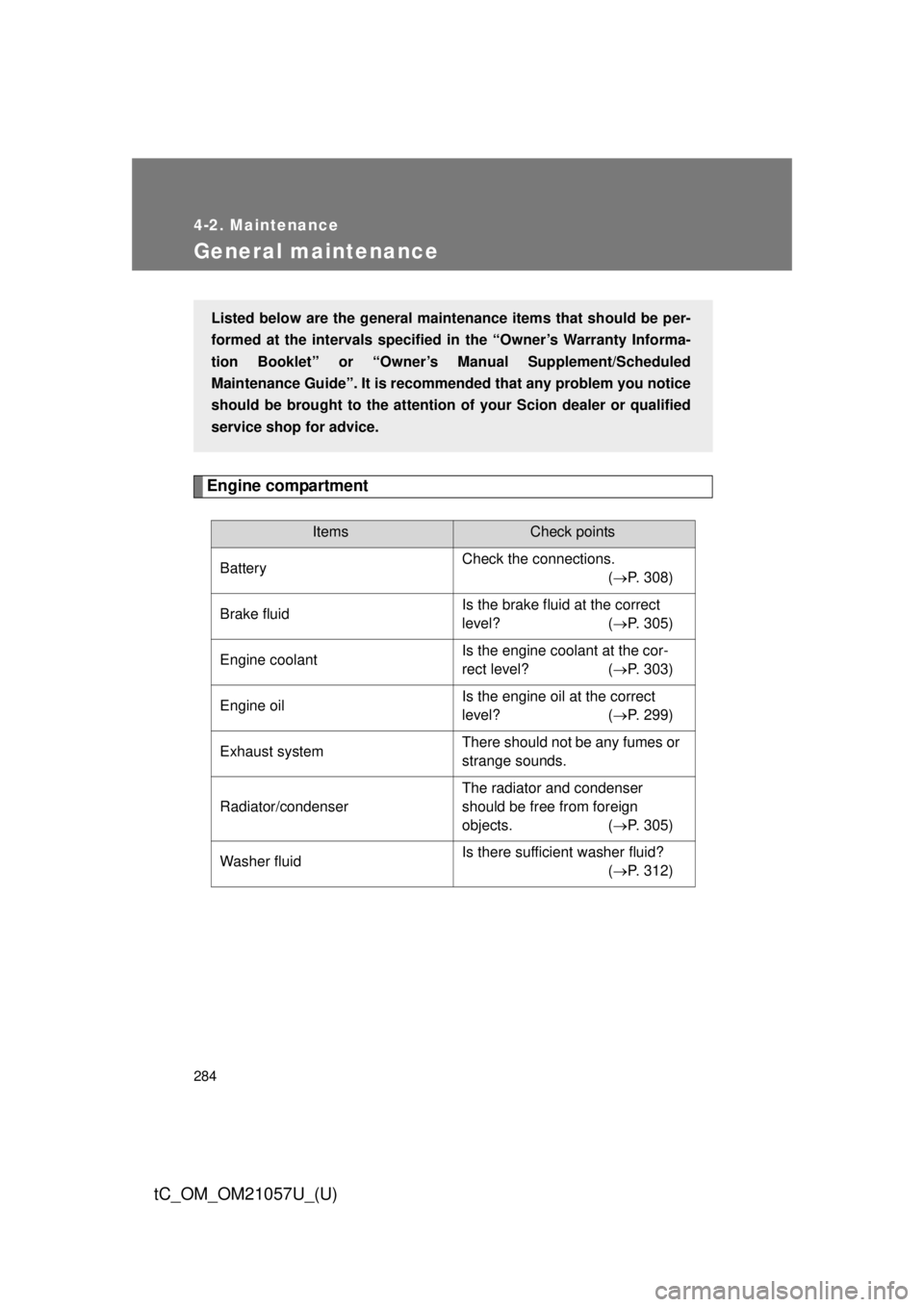
284
4-2. Maintenance
tC_OM_OM21057U_(U)
General maintenance
Engine compartment
ItemsCheck points
Battery Check the connections.
(P. 308)
Brake fluid Is the brake fluid at the correct
level? (
P. 305)
Engine coolant Is the engine coolant at the cor-
rect level?
(P. 303)
Engine oil Is the engine oil at the correct
level?
(P. 299)
Exhaust system There should not be any fumes or
strange sounds.
Radiator/condenser The radiator and condenser
should be free from foreign
objects.
(P. 305)
Washer fluid Is there sufficient washer fluid?
(P. 312)
Listed below are the general maintenance items that should be per-
formed at the intervals specified in the “Owner’s Warranty Informa-
tion Booklet” or “Owner’s Manual Supplement/Scheduled
Maintenance Guide”. It is recommended that any problem you notice
should be brought to the attention of your Scion dealer or qualified
service shop for advice.
Page 291 of 492
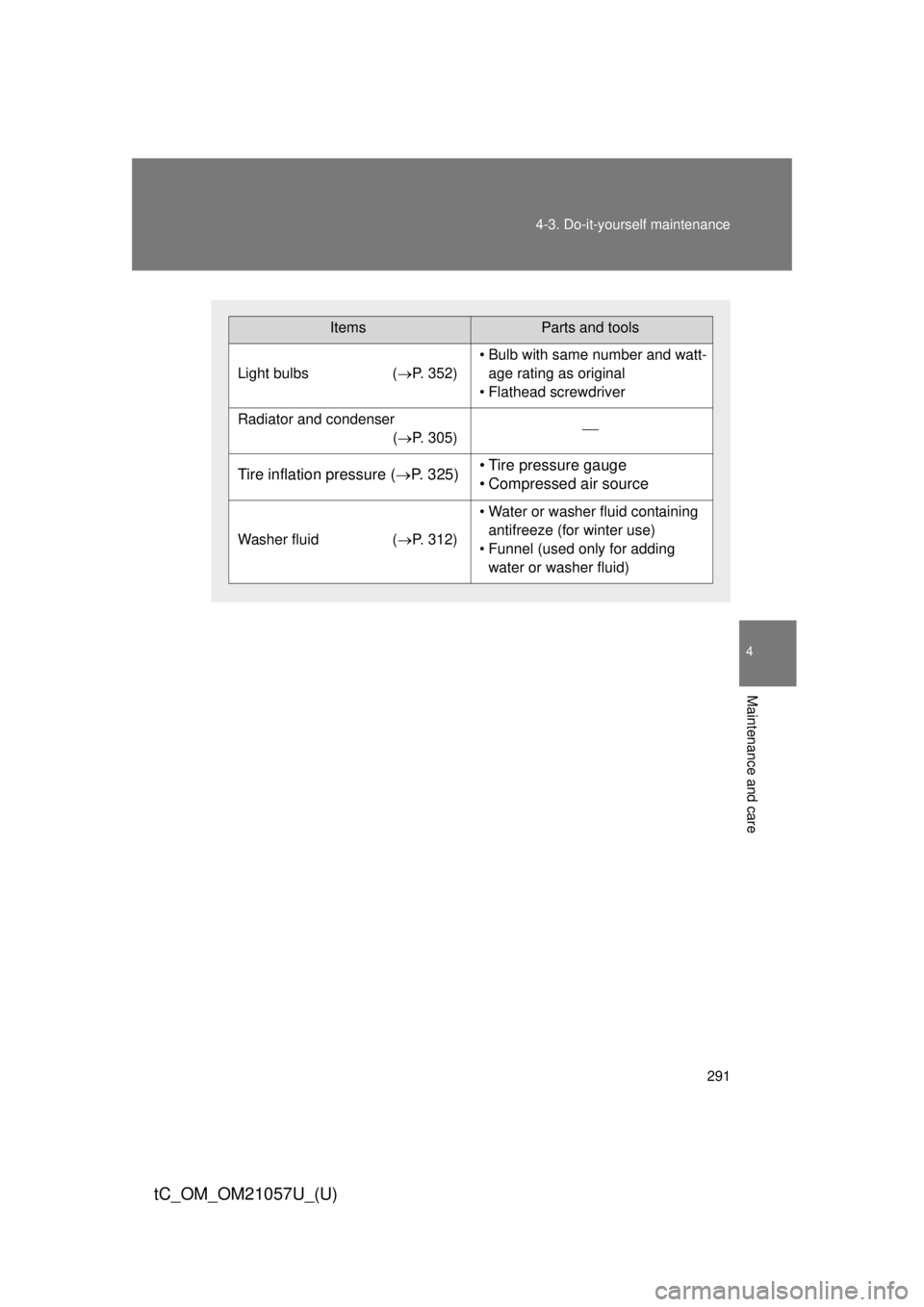
291
4-3. Do-it-yourself maintenance
4
Maintenance and care
tC_OM_OM21057U_(U)
ItemsParts and tools
Light bulbs
(P. 352)
• Bulb with same number and watt-
age rating as original
• Flathead screwdriver
Radiator and condenser (P. 305)
Tire inflation pressure ( P. 325)• Tire pressure gauge
• Compressed air source
Washer fluid (P. 312)
• Water or washer fluid containing
antifreeze (for winter use)
• Funnel (used only for adding water or washer fluid)
Page 292 of 492

292 4-3. Do-it-yourself maintenance
tC_OM_OM21057U_(U)
CAUTION
The engine compartment contains many mechanisms and fluids that may
move suddenly, become hot, or become electrically energized. To avoid death
or serious injury, observe the following precautions:
■When working on the engine compartment
●Keep hands, clothing and tools away from the moving fan and engine
drive belt.
● Be careful not to touch the engine, radiator, exhaust manifold, etc. right
after driving as they may be hot. Oil and other fluids may also be hot.
● Do not leave anything that may burn easily, such as paper and rags, in the
engine compartment.
● Do not smoke, cause sparks or expose an open flame to fuel or the bat-
tery. Fuel and battery fumes are flammable.
● Be extremely cautious when working on the battery. It contains poisonous
and corrosive sulfuric acid.
Page 293 of 492
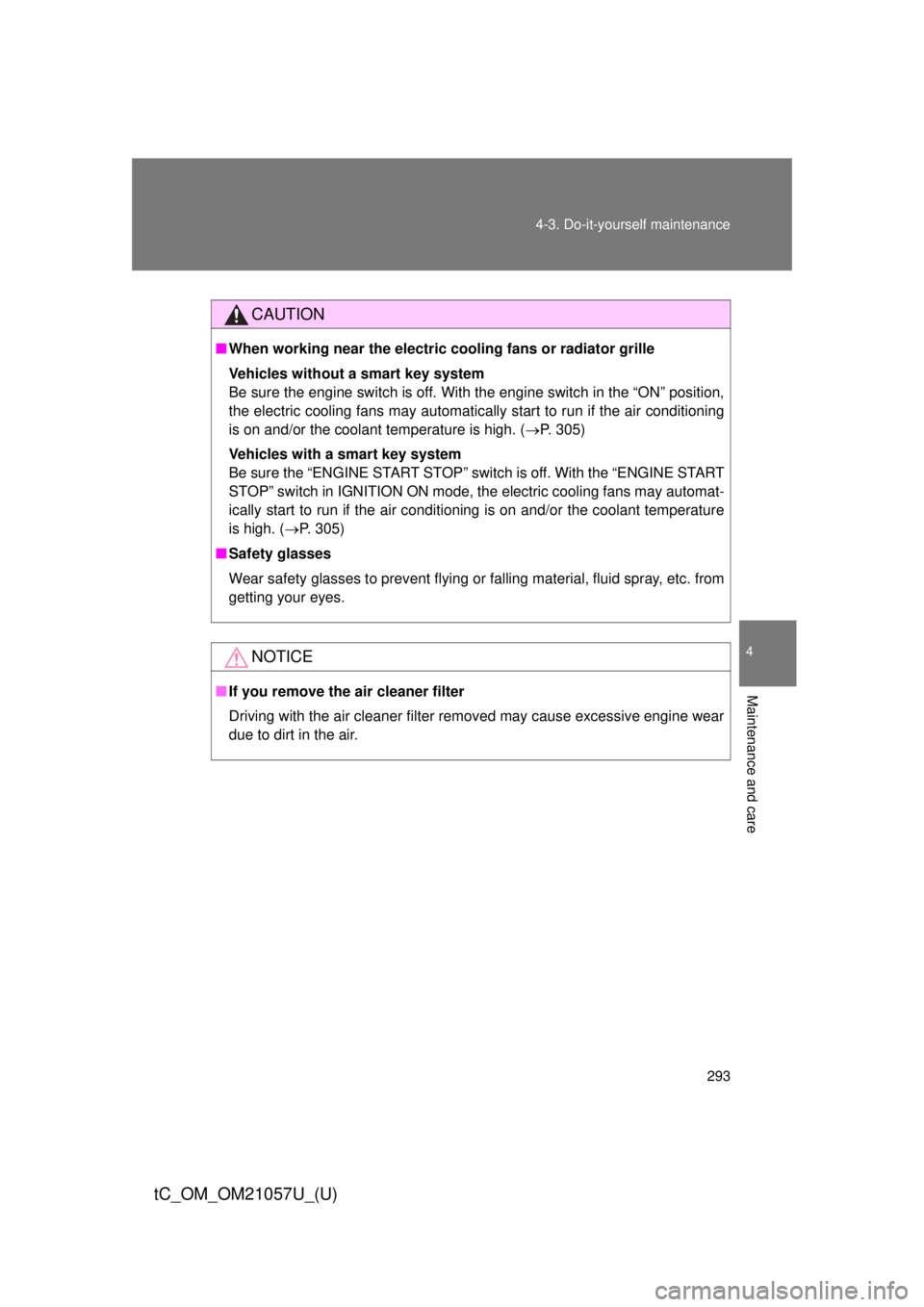
293
4-3. Do-it-yourself maintenance
4
Maintenance and care
tC_OM_OM21057U_(U)
CAUTION
■
When working near the electric c ooling fans or radiator grille
Vehicles without a smart key system
Be sure the engine switch is off. With the engine switch in the “ON” position,
the electric cooling fans may automatically start to run if the air conditioning
is on and/or the coolant temperature is high. ( P. 305)
Vehicles with a smart key system
Be sure the “ENGINE START STOP” switch is off. With the “ENGINE START
STOP” switch in IGNITION ON mode, the electric cooling fans may automat\
-
ically start to run if the air conditioning is on and/or the coolant temperature
is high. ( P. 305)
■ Safety glasses
Wear safety glasses to prevent flying or falling material, fluid spray, etc. from
getting your eyes.
NOTICE
■If you remove the air cleaner filter
Driving with the air cleaner filter removed may cause excessive engine wear
due to dirt in the air.
Page 298 of 492
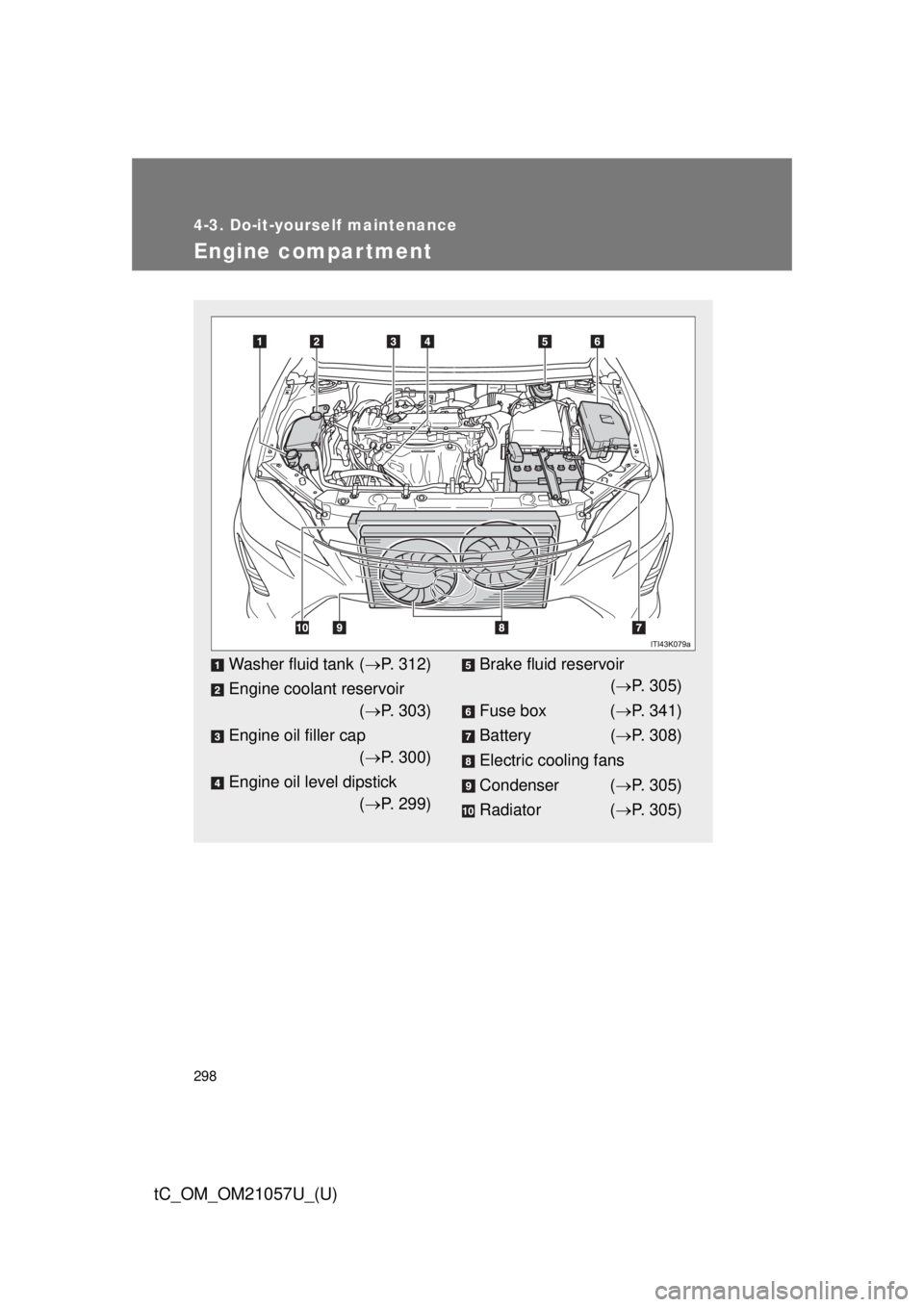
298
4-3. Do-it-yourself maintenance
tC_OM_OM21057U_(U)
Engine compar tment
Washer fluid tank (P. 312)
Engine coolant reservoir ( P. 303)
Engine oil filler cap ( P. 300)
Engine oil level dipstick ( P. 299)Brake fluid reservoir
( P. 305)
Fuse box ( P. 341)
Battery ( P. 308)
Electric cooling fans
Condenser ( P. 305)
Radiator ( P. 305)
Page 303 of 492
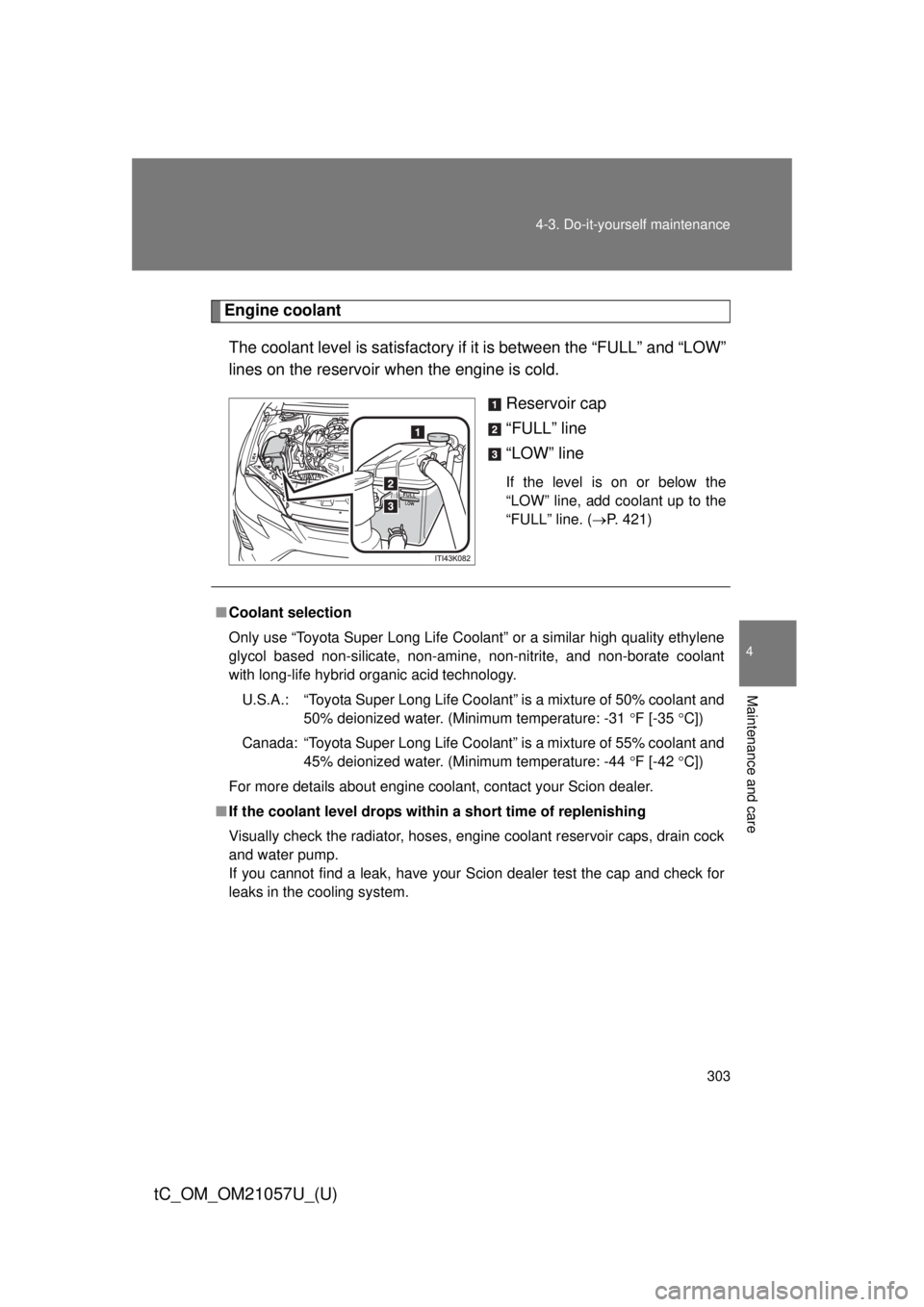
303
4-3. Do-it-yourself maintenance
4
Maintenance and care
tC_OM_OM21057U_(U)
Engine coolant
The coolant level is satisfactory if it is between the “FULL” and “LOW”
lines on the reservoir when the engine is cold.
Reservoir cap
“FULL” line
“LOW” line
If the level is on or below the
“LOW” line, add coolant up to the
“FULL” line. (P. 421)
■Coolant selection
Only use “Toyota Super Long Life Coolant” or a similar high quality ethylene
glycol based non-silicate, non-amine, non-nitrite, and non-borate coolant
with long-life hybrid organic acid technology.
U.S.A.: “Toyota Super Long Life Coolant” is a mixture of 50% coolant and 50% deionized water. (Minimum temperature: -31 F [-35 C])
Canada: “Toyota Super Long Life Coolant” is a mixture of 55% coolant and 45% deionized water. (Minimum temperature: -44 F [-42 C])
For more details about engine coolant, contact your Scion dealer.
■ If the coolant level drops within a short time of replenishing
Visually check the radiator, hoses, engine coolant reservoir caps, drain cock
and water pump.
If you cannot find a leak, have your Scion dealer test the cap and check for
leaks in the cooling system.
Page 305 of 492
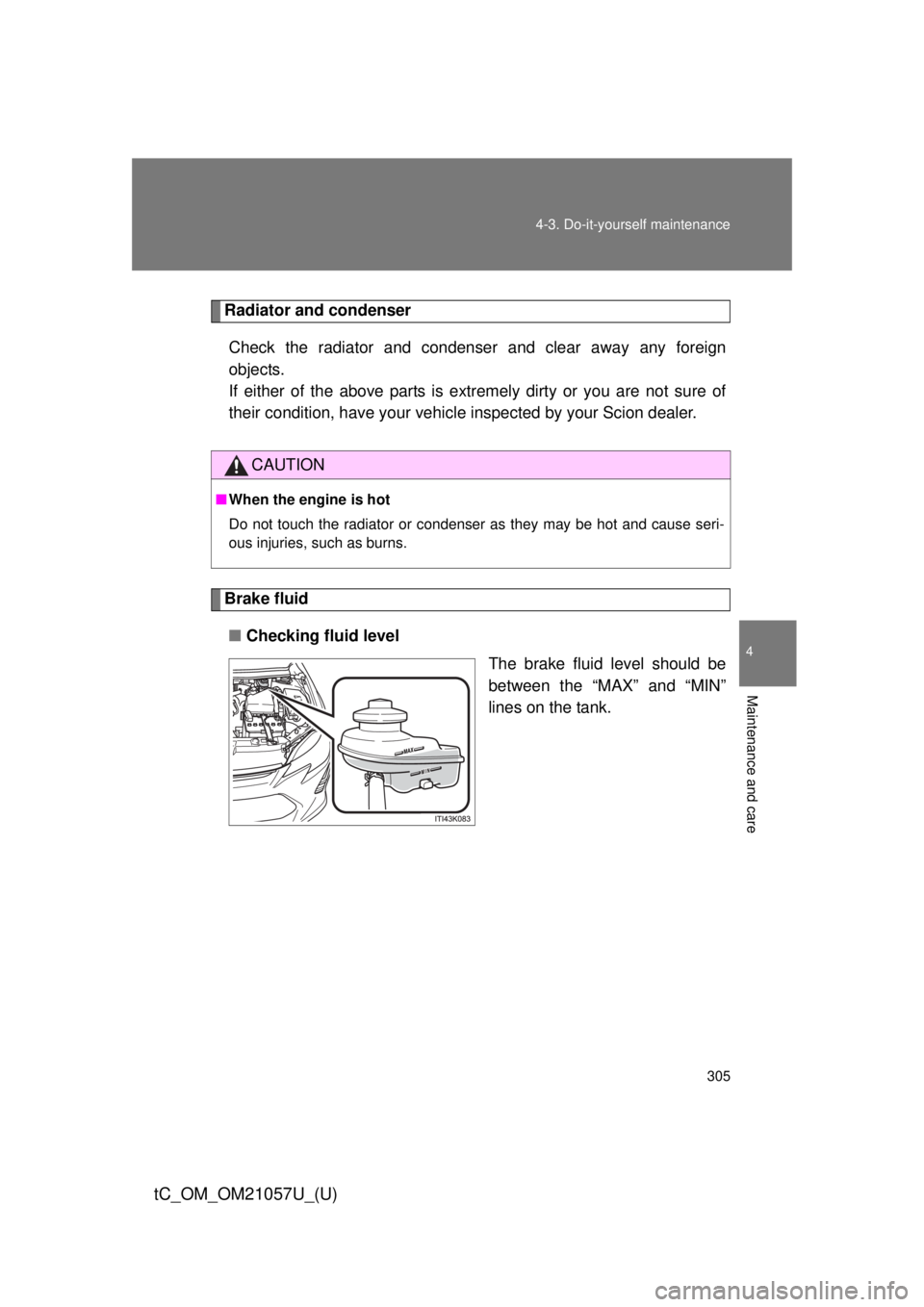
305
4-3. Do-it-yourself maintenance
4
Maintenance and care
tC_OM_OM21057U_(U)
Radiator and condenser
Check the radiator and condenser and clear away any foreign
objects.
If either of the above parts is extremely dirty or you are not sure of
their condition, have your vehicl e inspected by your Scion dealer.
Brake fluid
■ Checking fluid level
The brake fluid level should be
between the “MAX” and “MIN”
lines on the tank.
CAUTION
■When the engine is hot
Do not touch the radiator or condenser as they may be hot and cause seri-
ous injuries, such as burns.
Page 421 of 492
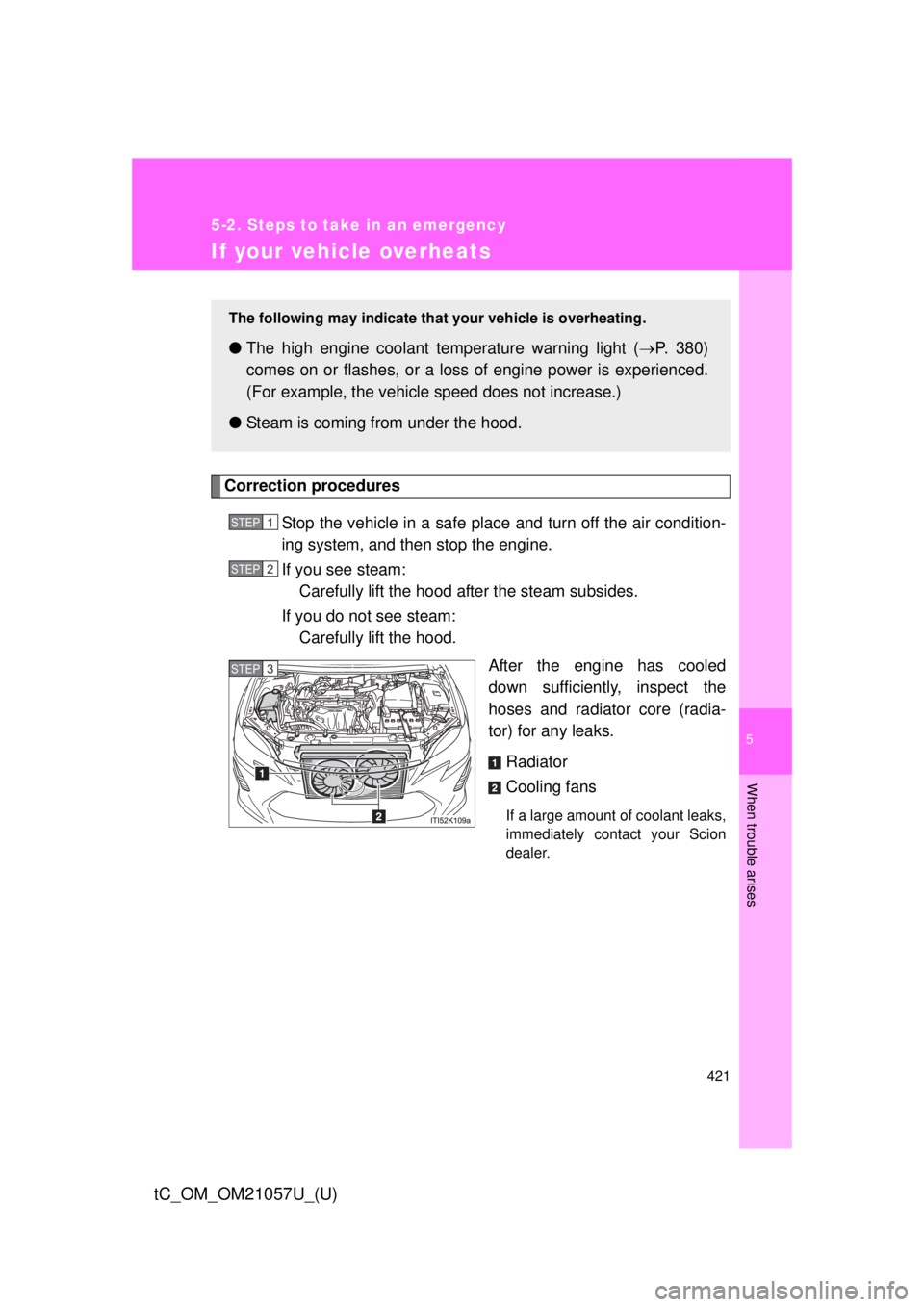
5
When trouble arises
421
5-2. Steps to take in an emergency
tC_OM_OM21057U_(U)
If your vehicle overheats
Correction proceduresStop the vehicle in a safe place and turn off the air condition-
ing system, and then stop the engine.
If you see steam: Carefully lift the hood after the steam subsides.
If you do not see steam: Carefully lift the hood.
After the engine has cooled
down sufficiently, inspect the
hoses and radiator core (radia-
tor) for any leaks.
Radiator
Cooling fans
If a large amount of coolant leaks,
immediately contact your Scion
dealer.
The following may indicate that your vehicle is overheating.
●The high engine coolant te mperature warning light (P. 380)
comes on or flashes, or a loss of engine power is experienced.
(For example, the vehicl e speed does not increase.)
● Steam is coming from under the hood.
STEP 1
STEP 2
STEP 5 STEP 3
Page 422 of 492
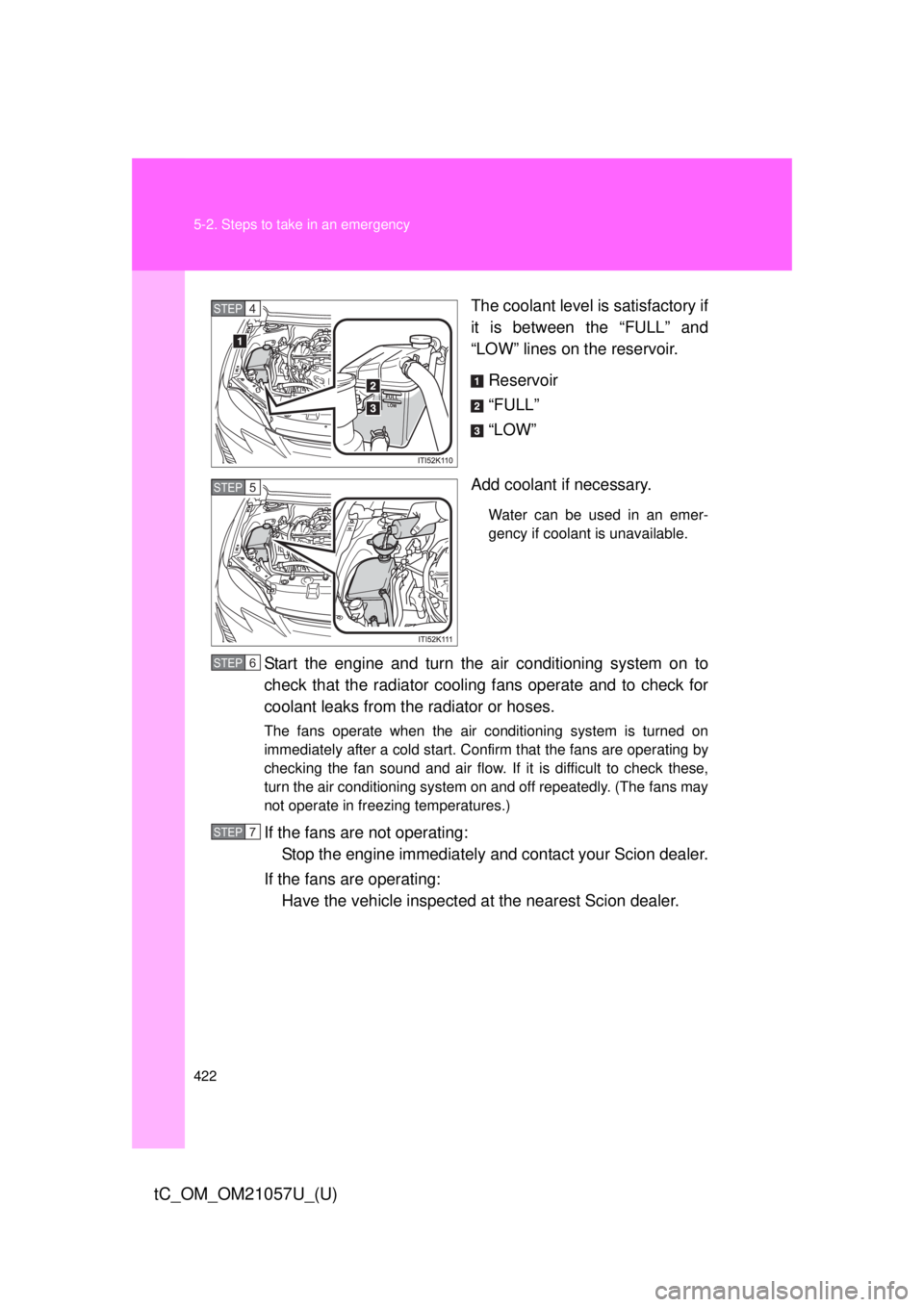
422 5-2. Steps to take in an emergency
tC_OM_OM21057U_(U)
The coolant level is satisfactory if
it is between the “FULL” and
“LOW” lines on the reservoir.Reservoir
“FULL”
“LOW”
Add coolant if necessary.
Water can be used in an emer-
gency if coolant is unavailable.
Start the engine and turn the air conditioning system on to
check that the radiator cooling fans operate and to check for
coolant leaks from t he radiator or hoses.
The fans operate when the air conditioning system is turned on
immediately after a cold start. Confirm that the fans are operating by
checking the fan sound and air flow. If it is difficult to check these,
turn the air conditioning system on and off repeatedly. (The fans may
not operate in freezing temperatures.)
If the fans are not operating:
Stop the engine immediately and contact your Scion dealer.
If the fans are operating: Have the vehicle inspected at the nearest Scion dealer.
STEP 4
STEP 5
STEP 6
STEP7
Page 423 of 492

5
When trouble arises
423
5-2. Steps to take in an emergency
tC_OM_OM21057U_(U)
CAUTION
■
To prevent an accident or injury when inspecting under the hood of
your vehicle
●If steam is seen coming from under the hood, do not open the hood until
the steam has subsided. The engine compartment may be very hot, caus-
ing serious injury such as burns.
● Keep hands and clothing (especially a tie, a scarf or a muffler) away from
the fans and belts. Failure to do so may cause the hands or clothing to be
caught, resulting in serious injury.
● Do not loosen the coolant reservoir cap while the engine and radiator are
hot.
Serious injury, such as burns, may result from hot coolant and steam
released under pressure.
NOTICE
■When adding engine coolant
Wait until the engine has cooled down before adding engine coolant.
When adding coolant, do so slowly. Adding cool coolant to a hot engine too
quickly can cause damage to the engine.
■ To prevent damage to the cooling system
Observe the following precautions:
●Avoid contaminating the coolant with foreign matter (such as sand or dust
etc.).
● Do not use any coolant additive.